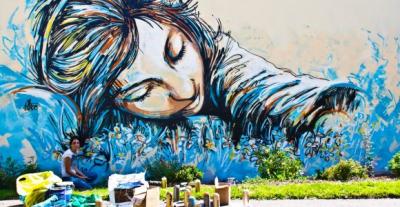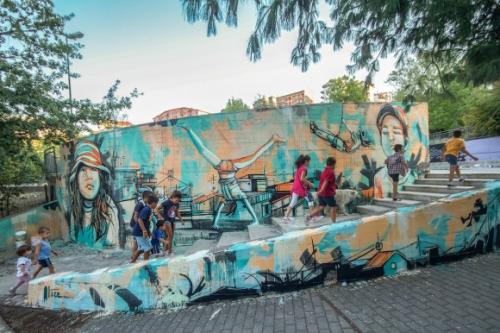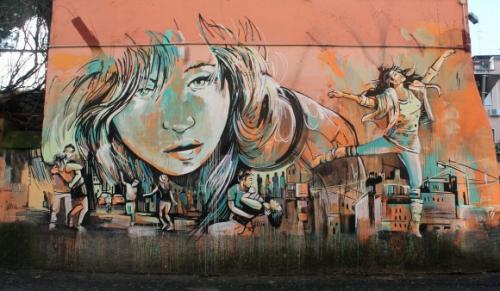Street art feminism

Alice Pasquini spray-paints the walls of Rome
By Christina Höfferer and Florence Brock
ROME -- London, Sydney, New York, Barcelona, Moscow, Saigon and, of course, Rome are the vibrant cities that exhibit colourful and expressive murals painted by Roman artist Alice Pasquini born in 1980. Alice grew up in Rome's Flaminio District, in Piazza Mancini, a large square near the Tiber River. Today, the shutters of two kiosks in Piazza Mancini are decorated with Alice’s spray paint images. "When I came back to Rome after being in France for a long time, it seemed logical to paint just outside my front door," says Alice Pasquini. Soon after painting the kiosks, she also called on the operator of a bicycle workshop near the neighborhood Auditorium, embellished his business and, later, prestigious commissions followed.
The hip-hop scene of the 1990’s marked Alice’s socialisation as an adolescent. She was inspired by the comic heroine Sprayliz who was the author of spray painted political statements on walls in the form of graffiti. Influenced by Sprayliz, Alice visited the Art Academy in Rome, studied Animation and Art Criticism in Madrid and lived in London for a year. Illustrations, as well as stage and set designs, are also part of the artist’s portfolio. "At the Academy, I was warned that painting is dead," says Alice, yet she still became a painter. "My professors taught me that this art form died with Duchamp, so I wanted out of the studio, out of the academic circles." Today, Alice Pasquini has returned to these circles because street art is now an established art form. Prior to becoming an art student in London, the artist explained the differences she learned from attending Roman lectures among sprayed messages like "Laura, I love you, come back to me," Italian street decorations and elaborately designed murals crafted by artists. In Rome, Alice Pasquini has presented her work in shows at MACRO, at the American Embassy and in a sensational one-woman exposition at Casa dell'Architettura.
Her spray work in the Flaminio District includes the kiosks that were made possible with the permission of their owner. Together with fifteen other artists, Pasquini participated at the temporary art show of the Outdoor Festival at MAXXI Museum located in the Flaminio District during the autumn of 2015. Alice Pasquini’s spray cans have passed through Flaminio, Quadraro, Pigneto and the San Lorenzo District (featuring a large mural in Via dei Sabelli).
With street art that celebrates congenial, dark-haired Italian "strong and independent women", much like herself, two thousand houses and walls feature Alice Pasquini's female images and her signature. The women are thoughtful, self-confident, sensual, soulful and most cheerful. Often, children are also depicted on building walls. Considered very physical, the graffiti protagonists are seen on Vespas, rocking, jogging, or lying in the sun. "In April, I’m putting on a show in Dortmund and its theme is imperfection," says Pasquini in her atelier located in the San Lorenzo bohemian neighborhood. "Rome is a city of artists. Street art follows a thread that runs through the city, where every corner is filled with artists' designs. I grew up with this feeling that I wanted to seize the streets and leave my own imprint on them.” On the road, the relationship between artist and viewer is different from in a gallery; the dialogue is direct and immediate. "Messages on the road, which can be very critical at times, have a long tradition in Rome. Just think of Pasquino," says Alice. Pasquino is one of the "talking statues" of Rome. As with other sculptures from the ancient world, you can find messages attached to it with often harsh criticism of authorities and, in many cases, even Popes. Alice Pasquini playfully uses the homonym in common with Pasquino as an opportunity to express her reflections on art and society.
"I wanted to bring my own personal language to the street. As a woman, I do not see myself as a sexy comic heroine, nor as a naked advertising medium," says Alice Pasquini, "I want to show real women." It is more difficult to develop specific expression for women because, from an early age, their personality is already imprinted. "As children, women are full of energy. When they grow up, they often run into conflict. Suddenly, they are no longer the good girls." The artist scrutinizes what she sees on the streets, turning it into pictures on walls. Travelling between Morocco and Russia, she has observed very different images of women. "Often people write me and say: “That’s me! You’ve painted me there!” explains Alice Pasquini, who emphasizes "mine are general representations which are comprised of the individual impressions I get of the women I see."
"I witness a lot of cynicism around me, even in language. Speaking about beauty and humanity are often considered trivial, but that's my mission." Alice Pasquini wants to re-discover humanity in everyday life. "Painting the walls of houses is a great symbol of freedom." Alice paints during the day and she signs her spray works. "Painting walls is my passion. I can beautify walls that have been ruined over time; a white wall does not interest me."
The Mayor of Rome, Ignazio Marino, has called the artist and has commissioned five paintings for the Capital, in the reception rooms for citizens of the Eternal City. Currently, there is an ongoing criminal trial in another city against Alice Pasquini. "It takes courage to spray. I do not feel like a thief. I'm not evil, but good for the city," says the artist, who is not allowed to talk about the case against her. Although she has sprayed over two thousand works on walls all over the world and is an international street art VIP, the young Roman woman has been reported and prosecuted in Bologna. Accusations: Pollution, Article 639 of the Italian Penal Code, aggravated by Article 81, continued offence. She faces a fine up to one thousand Euros and up to one year of imprisonment. The verdict is currently being appealed.
In Rome, however, you can read on city websites and publications that entire neighborhoods are being upgraded through street art. The City of Rome has even published a guide to murals. Faceless urban canyons receive an identity. Unlike night and fog spray works, large murals are executed on commission. Alice Pasquini: "So, now I’ve returned to the sort of art I fled from in the name of the freedom of the road."
We are now in the post graffiti era. There is more dialogue between sprayers and viewers; it is no longer only about expressing discomfort. The representations have become figurative; that is the revolution of spraying. The quality of colour is much better. Artists who work in a public space are always faced with the situation that the property being sprayed doesn’t belong to them. They are almost always places where they do not live and where they may never return. Pasquini therefore wants to create something that has artistic or political value. There’s no guarantee that the work of art will generate positive feelings in the people who have to live with it every day. "That's the risk that I take with my art form," says Alice Pasquini. Sometimes she is also asked if she gets paid for spraying her acrylic paint works, but she replies that artistic activity does not always have to be followed by payment. "I want people to feel more at home in their city; I want to share their dreams."
SERVICE:
Alice Pasquini
STREETART ROMA map can be downloaded at:
www.turismoroma.it/wp-content/uploads/2015/04/leaflet_streetart.pdf
ch-ch+fb




